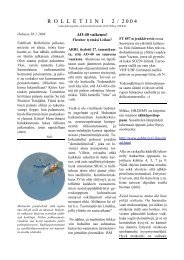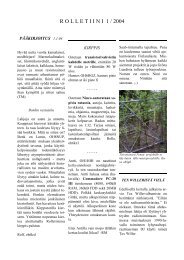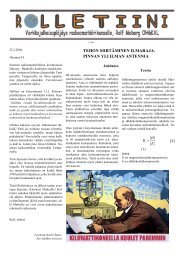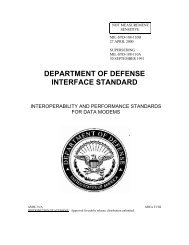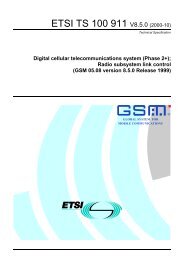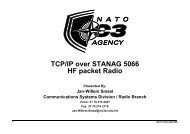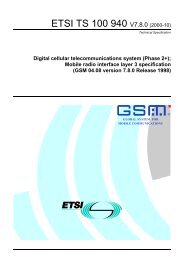nato unclassified - Ham-pages ... No indexes at this level
nato unclassified - Ham-pages ... No indexes at this level
nato unclassified - Ham-pages ... No indexes at this level
You also want an ePaper? Increase the reach of your titles
YUMPU automatically turns print PDFs into web optimized ePapers that Google loves.
NATO UNCLASSIFIED<br />
STANAG 5066: PROFILE FOR MARITIME HF DATA COMMUNICATION<br />
V1.0.2<br />
START<br />
NO<br />
HAS A<br />
TYPE 3 S_PDU<br />
(HARD LINK ESTBLSM NT REQUEST)<br />
BEEN RCVED FROM<br />
PEER<br />
<br />
YES<br />
NO<br />
CAN<br />
THE REQUEST<br />
FOR HARD LINK<br />
BE ACCEPTED<br />
<br />
YES<br />
SEND A<br />
TYPE 5 S_PDU<br />
(HARD LINKESTBLSMNTREJECTED)<br />
TO CALLING PEER<br />
SEND A<br />
TYPE 4 S_PDU<br />
(HARD LINKESTBLSMNTCONFIRM )<br />
TO CALLING PEER<br />
HARD LINK<br />
REJECTED<br />
HARD LINK<br />
ESTABLISHED<br />
Figure A-5 (b): Procedures for Establishing a Hard Link: CALLED PEER<br />
A.3.2.2.2<br />
Protocol for Termin<strong>at</strong>ing a Hard Link D<strong>at</strong>a Exchange Session<br />
The termin<strong>at</strong>ion of the Hard Link can be initi<strong>at</strong>ed by either of the two peer sublayers.<br />
<strong>No</strong>rmally the Hard Link will be termin<strong>at</strong>ed by the Calling Peer <strong>at</strong> the request of the Client<br />
who initi<strong>at</strong>ed it, or by either of the peers if they receive a higher Priority Hard Link Request<br />
from one of their other Clients. The peer which wishes to termin<strong>at</strong>e the Hard Link, sends a<br />
“HARD LINK TERMINATE” (type 6) S_PDU. The receiving Peer immedi<strong>at</strong>ely declares the<br />
Hard Link as termin<strong>at</strong>ed and responds with a “HARD LINK TERMINATE CONFIRM”<br />
(type 7) S_PDU. The initi<strong>at</strong>ing peer upon receiving <strong>this</strong> response (or after a specified timeout)<br />
also declares the Hard Link as termin<strong>at</strong>ed. Both peers inform their clients according to<br />
the rules associ<strong>at</strong>ed with the S_HARD_LINK_TERMINATED primitively. These S_PDUs<br />
should be submitted to the Channel Access Sublayer as<br />
C_EXPEDITED_UNIDATA_REQUEST Primitives<br />
.<br />
After termin<strong>at</strong>ion of the Hard Link with a subnetwork client, the Physical Link between the<br />
nodes may need to be broken. <strong>No</strong>rmally the breaking of the Physical Link is left to the peer<br />
which requested the termin<strong>at</strong>ion of the Hard Link session. The reason for <strong>this</strong> is th<strong>at</strong> <strong>this</strong> peer<br />
may want to start another session using the existing Physical Link in which case breaking and<br />
making procedures may be avoided. The procedures for breaking a Physical Link are<br />
explained in Annex B.<br />
The procedures for Termin<strong>at</strong>ing a Hard Link by both the Requesting and Responding Peers<br />
are shown in Figure A-6.<br />
NATO UNCLASSIFIED<br />
36




